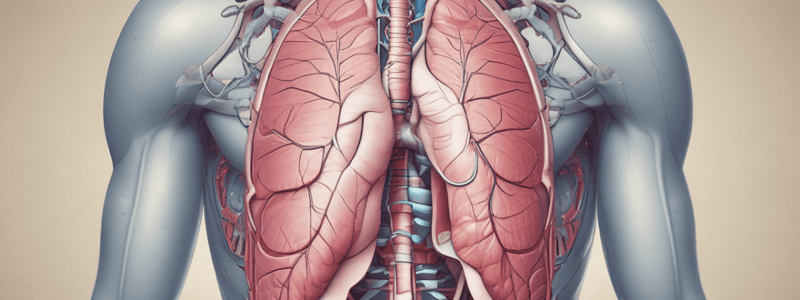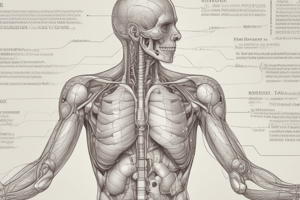Podcast
Questions and Answers
Which of the following nerves pierces the left dome of the diaphragm?
Which of the following nerves pierces the left dome of the diaphragm?
- Greater splanchnic nerve
- Right phrenic nerve
- Lesser splanchnic nerve
- Left phrenic nerve (correct)
Which of the following is NOT a weak point of the diaphragm?
Which of the following is NOT a weak point of the diaphragm?
- Thoracic opening (correct)
- Sternalcostal trigone
- Esophageal opening
- Lumbocostal trigone
Which artery is a branch of the internal thoracic artery?
Which artery is a branch of the internal thoracic artery?
- Musculophrenic Artery (correct)
- Inferior phrenic Artery
- Descending aorta
- Superior phrenic Artery
Which of the following is responsible for motor innervation of the diaphragm?
Which of the following is responsible for motor innervation of the diaphragm?
Which of the following hernias occurs in the anterior part of the diaphragm?
Which of the following hernias occurs in the anterior part of the diaphragm?
Which of the following is NOT an arterial supply of the diaphragm?
Which of the following is NOT an arterial supply of the diaphragm?
Which of the following nerves passes posterior to the medial arcuate ligament?
Which of the following nerves passes posterior to the medial arcuate ligament?
Which of the following is NOT a branch of the aorta?
Which of the following is NOT a branch of the aorta?
Which of the following is responsible for sensory innervation of the central part of the diaphragm?
Which of the following is responsible for sensory innervation of the central part of the diaphragm?
Which of the following is a weak point of the diaphragm?
Which of the following is a weak point of the diaphragm?
Flashcards
Diaphragm
Diaphragm
The primary muscle for breathing, separating the chest and abdominal cavities.
Medial arcuate ligament
Medial arcuate ligament
Connects medial borders of the right and left crura of the diaphragm.
Lateral arcuate ligament
Lateral arcuate ligament
Connects transverse process of L1 to the 12th rib.
Actions of the Diaphragm
Actions of the Diaphragm
Signup and view all the flashcards
Aortic Opening
Aortic Opening
Signup and view all the flashcards
Esophageal Opening
Esophageal Opening
Signup and view all the flashcards
Caval Opening
Caval Opening
Signup and view all the flashcards
Bochdalek's Hernia
Bochdalek's Hernia
Signup and view all the flashcards
Morgagni Hernia
Morgagni Hernia
Signup and view all the flashcards
Diaphragm Motor Innervation
Diaphragm Motor Innervation
Signup and view all the flashcards
Study Notes
The Diaphragm
- The diaphragm is the principle muscle of respiration, forming the floor of the thoracic cavity and the roof of the abdominal cavity.
- It consists of a peripheral muscular part and a central tendinous part.
Relations of the Diaphragm
- Superior relations: pleura, base of the left and right lung, pericardium, and the diaphragmatic surface of the heart.
- Inferior relations: on the right, the lobes of the liver, right kidney, and right suprarenal gland; on the left, the left lobe of the liver, fundus of the stomach, left kidney, left suprarenal gland, and spleen.
Parts of the Diaphragm
- Sternal part: originates from the posterior surface of the xiphoid process and inserts into the central tendon.
- Costal part: originates from the lower 6 ribs and costal cartilages and inserts into the central tendon.
- Posterior vertebral or lumbar portion:
- Right crus: arises from the bodies of lumbar vertebrae 1-3 and the corresponding intervertebral discs.
- Left crus: arises from the sides of the first two lumbar vertebrae and the corresponding intervertebral discs.
- Medial arcuate ligament: connects the medial borders of the right and left crura.
- Lateral arcuate ligament: extends from the tip of the transverse process of L1 to the lower border of the 12th rib.
Actions of the Diaphragm
- Muscle of inspiration: pulls the central tendon down, increasing the vertical diameter of the thoracic cavity.
- Weight lifting muscle: fixes the diaphragm to rise the intra-abdominal pressure, supporting the vertebral column and preventing flexion during lifting.
- Muscle of abdominal straining: aids the contraction of anterior abdominal wall muscles, rising the intra-abdominal pressure to evacuate the pelvic content.
- Thoraco-abdominal pump: descent of the diaphragm decreases intra-thoracic pressure, increasing intra-abdominal pressure, compressing blood in the IVC and forcing it upwards.
Openings of the Diaphragm
- Aortic Opening (T12): aorta, thoracic duct, and azygos vein.
- Esophageal Opening (T10): esophagus, left and right vagus nerves, esophageal branch of left gastric vessels, and lymphatics from the lower 1/3 of the esophagus.
- Caval Opening (T8): IVC, terminal branch of the right phrenic nerve.
Additional Features
- Greater, lesser, and lowest splanchnic nerves pierce the crura.
- Sympathetic trunk passes posterior to the medial arcuate ligament.
- Superior epigastric vessels pass between the sternal and costal portions of the diaphragm.
- Left phrenic nerve pierces the left dome of the diaphragm.
Weak Points of the Diaphragm
- Lumbocostal trigone
- Sternalcostal trigone
- Esophageal opening
- Aortic opening
- Caval opening
Arterial Supply of the Diaphragm
- Superior phrenic artery (branch of the descending aorta)
- Inferior phrenic artery (branch of the abdominal aorta)
- Pericardiacophrenic artery (branch of the internal thoracic artery)
- Musculophrenic artery (branch of the internal thoracic artery)
Innervation of the Diaphragm
- Motor innervation: phrenic nerves (C 3, 4, 5)
- Sensory innervation:
- Peripheral part: intercostal nerves (T5-T11)
- Central part: phrenic nerve (C3, 4, 5)
Diaphragmatic Hernias
- Bochdalek's Hernia: posterior
- Morgagni Hernia: anterior
Studying That Suits You
Use AI to generate personalized quizzes and flashcards to suit your learning preferences.




